
Table of Contents
- Introduction
- Materials Commonly Used in Yard Signs
- Benefits of Different Yard Sign Materials
- Choosing the Right Material for Your Yard Sign
- Conclusion
Introduction
Yard signs are a popular and effective way to promote businesses, political campaigns, real estate listings, events, and more. They offer a cost-effective means of advertising that can reach a broad audience. But have you ever wondered, what are yard signs made of? Understanding the materials used in yard signs can help you choose the best option for your specific needs. This blog post will delve into the various materials used to manufacture yard signs, their benefits, and how to choose the right material for your next project.
Materials Commonly Used in Yard Signs
When it comes to yard signs, several materials are commonly used due to their durability, weather resistance, and cost-effectiveness. Let’s explore these materials in detail.
Corrugated Plastic
Corrugated plastic, often referred to as “coroplast,” is one of the most popular materials for yard signs. It’s lightweight, durable, and resistant to weather, making it ideal for outdoor use.
Key Features:
- Durability: Corrugated plastic is highly durable and can withstand various weather conditions, including rain, wind, and UV rays.
- Cost-Effective: This material is relatively inexpensive, making it a popular choice for large quantities of signs.
- Lightweight: Easy to handle and install, corrugated plastic signs can be placed just about anywhere with minimal effort.
Polyethylene
Polyethylene is another common material used in yard signs. It’s a type of plastic known for its flexibility and strength.
Key Features:
- Weather Resistant: Polyethylene can withstand harsh weather conditions, making it suitable for long-term outdoor use.
- Flexible: Unlike more rigid materials, polyethylene can bend without breaking, which can be advantageous in windy conditions.
- Recyclable: This material is eco-friendly as it can be recycled after use.
Aluminum
Aluminum yard signs offer a premium look and feel. They are known for their durability and sleek appearance.
Key Features:
- Long-Lasting: Aluminum is highly resistant to rust and corrosion, ensuring the sign remains in good condition over time.
- Professional Appearance: The smooth, glossy finish of aluminum gives yard signs a high-quality, professional look.
- Sturdy: Aluminum signs are more rigid than plastic alternatives, making them ideal for areas with high winds or where vandalism might be a concern.
PVC
PVC (polyvinyl chloride) is a versatile material used in various applications, including yard signs. It’s known for its robustness and versatility.
Key Features:
- Durable: PVC signs are durable and can handle exposure to elements without deteriorating quickly.
- Smooth Surface: The smooth surface of PVC allows for high-quality printing, ensuring that your design looks crisp and vibrant.
- Versatile: PVC can be used for both indoor and outdoor signs, offering flexibility in how and where the signs can be displayed.
Wood
While not as common as plastic or metal options, wood is still used for certain types of yard signs, particularly those intended for a more rustic or natural look.
Key Features:
- Aesthetic Appeal: Wood signs offer a unique, natural aesthetic that can be very appealing for certain applications, such as real estate or garden signs.
- Customizable: Wood can be easily cut, shaped, and painted to meet specific design requirements.
- Biodegradable: As a natural material, wood is environmentally friendly and biodegradable.
Benefits of Different Yard Sign Materials
Each material used in yard signs comes with its own set of benefits, tailored to different needs and environments.
- Corrugated Plastic: Affordable, lightweight, and weather-resistant. Ideal for short-term use and high-volume campaigns.
- Polyethylene: Flexible, durable, and recyclable. Suitable for both short-term and long-term usage.
- Aluminum: Sleek, professional, and long-lasting. Perfect for high-visibility areas and long-term advertising.
- PVC: Durable, versatile, and capable of high-quality prints. Great for a variety of indoor and outdoor applications.
- Wood: Aesthetic, customizable, and eco-friendly. Best for niche markets and special occasions.
Choosing the Right Material for Your Yard Sign
When deciding on the material for your yard sign, consider the following factors:
- Duration of Use: If you need the sign for a short-term event, cost-effective materials like corrugated plastic or polyethylene may be best. For long-term use, consider more durable options like aluminum or PVC.
- Environmental Conditions: For areas with extreme weather conditions, materials like aluminum and polyethylene that offer high weather resistance are ideal.
- Budget: Corrugated plastic is budget-friendly for large campaigns, while aluminum offers a higher-end appearance at a higher cost.
- Aesthetic Needs: If the look and feel of the sign are crucial, materials like aluminum and wood provide a more premium and customizable appearance.
- Environmental Impact: If sustainability is a concern, choosing recyclable materials like polyethylene or biodegradable options like wood can be beneficial.
Conclusion
Understanding the different materials used in yard signs can significantly impact the effectiveness and longevity of your advertising efforts. Whether you’re looking for a budget-friendly option for a short-term campaign or a durable, professional-looking sign for long-term use, there’s a material that fits your needs. By considering the specific requirements of your project, including duration, environmental conditions, budget, aesthetic needs, and environmental impact, you can make an informed decision that ensures your yard signs are both effective and durable.
Investing in the right yard sign material not only enhances your message’s visibility but also ensures that your signage remains intact and visually appealing throughout its intended lifespan. Whether you choose corrugated plastic, polyethylene, aluminum, PVC, or wood, understanding the benefits and uses of each material will help you create the perfect yard sign for your needs.
